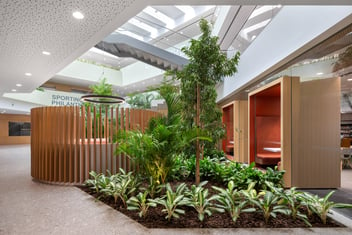Biophilic Design: Answering the Call of the Wild
As a professional in the building industry, have you ever stopped to consider the impact of our concrete cities on our health and well-being?
Have you wondered about the concrete jungles we've built and the natural habitats we have displaced?
Every day, millions of us wake up in these urban environments. We live, work, and play in structures that, while impressive feats of engineering, often lack the natural elements that are crucial to our well-being.
We navigate through them, often spending most of our time indoors, under artificial light, breathing in recycled air. These can sometimes make us feel devoid of life, cold and unwelcoming. They're often noisy, polluted, and bustling with frenetic energy that can be overwhelming.
There is no doubt, this urban lifestyle has consequences.
Research shows it can take a toll on our mental and physical health. Stress, anxiety, depression are just some of the issues linked to urban living. Obesity and childhood asthma rates are increasingly higher particularly in urban areas.
And let's not forget about the quality of life. The lack of green spaces in many cities means fewer opportunities for physical activity and social interaction. It means less access to fresh air and less exposure to the soothing effects of nature.
When the world came to a halt in 2020 we all experienced locked down and had to stay within our homes. It was then that we realised just how much we had been missing. We realised our homes need to support our wellbeing, physically, mentally, spiritually and emotionally. We understood we all have a need to be in touch with nature.
The truth is, the more we expand our urban landscapes, the more we critically need to increase sustainable solutions.
But how? How do we design our cities that integrates nature, promotes health and well-being? A city designed with a focus on the well-being of its inhabitants. A city that's not just about buildings and infrastructure but about people and nature living in harmony?
The Concept of Biophilic Design
Biophilia, a term coined by biologist Edward O. Wilson, refers to our deep, instinctive bond with nature.
In our increasingly urbanised world, where concrete and glass dominate, this connection is more vital than ever. Because, as humans, we have an innate need to be in touch with nature. It's an acknowledgment that we humans are, at our core, creatures of the environment, despite our technological advancements and skyscraping cities. Which is why we crave the serenity of forests, the rhythm of waves, and the spectacle of a sunset when we go on holiday.
So, how does biophilic design answer this call of the wild?
The Journey to a Greener City
How do we make the leap from grey to green?
Well, the journey begins with a vision, a blueprint that replaces the concrete with canopies and asphalt with arboretums. This is where stakeholder collaborations are needed, where architects, designers, and engineers step in, wielding their expertise and creative mindsets as tools to transform our cityscapes.
Our role extends beyond just designing; we also need to advocate for and implement sustainable design solutions and practices.
The first step in this transformation is integrating nature into our cities. This includes incorporating green spaces like parks and gardens but also extends to designing individual buildings. Understanding that spaces in between buildings are critical. Facades can be designed to host landscaping, rooftop gardens and vertical gardens.
Sustainability is not just about simply adding greenery to a building. Environments must be created and taken into account to encourage interaction and engagement with nature. This could mean designing walkways that meander through parks, or creating communal spaces that are enveloped by greenery.
The key is to create a seamless blend of the built and natural environments.
Of course, this journey also comes with its own set of challenges. Urban spaces are often limited, and finding room for expansive green spaces can be challenging.
Another challenge is maintaining these green spaces. This requires commitment from regulatory authorities and the community. Then there's the challenge of making this transition sustainable. It's not enough to plant trees; we must also ensure these ecosystems are self-sustaining and contribute positively to the wellbeing of the end user and the city's overall environment.
In the end, all stakeholders, from architects and designers to the city planners, authorities and residents, must work together to bring this vision to life. It's a collaborative effort, one that requires commitment, creativity, and, yes, a little bit of courage.
The road to a greener city is not easy, but it's a journey worth taking.
Applying Biophilic Design to Our Lives
The benefits of biophilic design are vast and far-reaching. It's not just about aesthetics but our health, productivity, and overall well-being.
Incorporating nature into our daily environments can reduce stress, improve cognitive function, and enhance mood and creativity. It can result in lower absenteeism, increased creativity and create a sense of tranquility in bustling cities and foster a sense of community among residents.
By encouraging the use of local and sustainable materials, promoting energy efficiency through natural light and ventilation, and integrating green spaces that can absorb CO2, this design philosophy can help create cities that are both livable and environmentally friendly.
Biophilic design is about reimagining our relationship with nature, not as something separate and distant, but as an integral part of our daily lives and spaces.
Biophilic Design is not just a philosophy; it's a practical approach that can transform our cities and our lives.
It's not just about making our cities look prettier; biophilic design can have a tangible, positive impact on our health and well-being. By supporting and advocating for biophilic design in our cities, we can help bring about this transformation.
By Christine Espinosa-Erlanda, Associate Director, Godwin Austen Johnson
.png)














